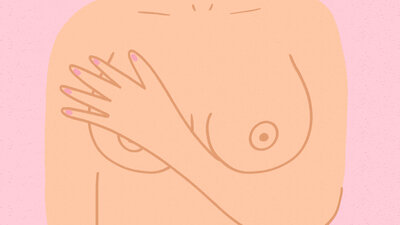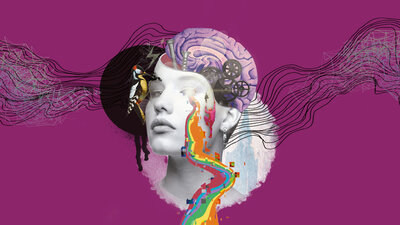This is Time for Myself

Many women experience the classic menopausal symptoms as quite severe.
© F1online/Westend61 GmbH/Emma Innocenti
A new generation of women is currently entering the menopause. Active, open-minded and well-informed women who are no longer willing to keep quiet about this phase of their life. In the past, the menopause has often been a taboo: Hot flushes, sleep disorder or cycle problems were a conversation topic among those affected - but certainly not for the public. But that has changed for good. ‘These are women who are no longer in the mood for this taboo. They want to talk about it, including with their partners’, says Miriam Stein. She has written a book about her own experiences during the menopause (‘Die gereizte Frau’, roughly translating as ‘The Irritable Woman’). And she has observed: ‘We are the first generation to tackle the topic so forwardly.’ All of a sudden, Instagram accounts, podcasts and start-ups are dealing with the ‘fabulous menopause’, as gynaecologist Dr Sheila de Liz calls the climacteric period in her bestselling book ‘Woman on Fire’.
Changes from the menopause
The new public interest is justified: In Germany, an estimated eight million women over 40 are currently in the menopause. A large target group wanting to know what exactly happens when hormone levels drop and the cycle goes crazy – and what helps against hot flushes, sleep disorder or depressive moments. First changes come in the so-called pre-menopause in the early 40s – usually barely noticeable. The menstrual cycle begins to fluctuate, the phase between the bleedings can be longer or shorter. The ovules no longer grow as reliably as they used to in the ovaries. First afflictions may also occur: mood swings or sleeping problems.
The pre-menopause is followed by the perimenopause – the actual menopause. It lasts from about one year before to one year after the last menstrual period. Hormone levels are on a rollercoaster, especially oestrogen and progesterone. The menstrual period is sometimes absent for weeks, but may then return with a heavy and long bleeding. Hot flushes are also common: Sudden sweats that disappear as quickly as they came – but significantly affect life.
The last bleeding marks the end of the fertile phase in a woman’s life – at the age of 51 years on average. When twelve months have passed since the last menstruation, this is called the menopause – which, strictly speaking, is thus not a phase, but a specific point in time.
Normalising the menopause
Miriam Stein was in her mid-40s when she was catapulted into the perimenopause. She has realised that the menopause may be a normal phase in a woman’s life – like puberty or pregnancy. However: Many women experience the classic menopausal symptoms as quite severe. A third of all women suffer massively and do not consider this ‘normal’. In addition, the menopause is also an encounter with one’s age, the end of fertility - and visibility. ‘In our society, it is the young women who are perceived as energetic and sexy. Women from the age of 40 are fading away’, Stein says. She adds: ‘I could agree with the sentence “The menopause is a normal phase” if we lived in a different kind of society.’
A society in which women of all ages are visible and important. A society in which the perimenopause is no taboo, a hot flush in a meeting is normal, calling in sick because of menopausal symptoms is not something to be ashamed of. ‘It should not be embarrassing not to be able to come to work because of it. No one ridicules me if I stay home because of back pain.’
The menopause does not just concern the women who are currently enduring it. All of society, politics and – above all – employers have to come to terms with it: Because menopausal women are right in the middle of their working lives – and they are needed. ‘Plenty of women work in systemically relevant jobs. To simply leave them to their suffering is unsolidaric and economically unwise’, according to Miriam Stein. ‘That’s why it’s vital for our society as a whole to address this issue.’
First companies are looking for solutions: The Bank of Ireland, for example, grants affected female employees up to ten extra days of leave per year if they suffer from menopausal symptoms. The background: In a survey of over 2000 women in the British financial sector, half of the interviewees said they were thinking about changing jobs or taking early retirement – because of menopausal symptoms. The Dublin-based bank does not want to lose these female employees. At the German software company SAP, health expert Dr Natalie Lotzmann has initiated an information campaign, and the menopause is also a regular topic in the SAP in-house newsletter. ‘Specifically in order to encourage our female employees with all their valuable potential to contribute beyond midlife, we want to free the topic of “handicap due to menopause” from taboos and support those affected with group seminars and counselling’, Lotzmann explains.
The feelings: subjective
With the menopause, a woman’s fertile years are over – for good. For some, this can be associated with sadness: That is quite normal. Others feel joy and relief. And many woman probably experience both. The menopause marks an end, but is also a new beginning: ‘Yes, we lose something, that can’t be glossed over’, says Miriam Stein. ‘But we gain so much: new energy, new capacities. More time for myself, a better relationship with my body. More self-love, more self-confidence.’ It is worth taking stock now, advises the author: What have I achieved in my life already, the crises I have overcome, and how have I become who I am? ‘That generates unbelievable strength: If I’ve mastered that, I’ll also master the second half of my life’.
Women entering the climacteric period today have about as many years ahead of them as they have behind them. They are women who approach their second half with self-confidence and curiosity. They have less and less need to please others or to conform. Women who know what they need and want. And what they can do without. Who look after others, but also take good care of themself. Courageous women who plan a trip around the world or start a business. Who might end relationships and find new companionship. These are women whose life could not be more different from that of their mother and grandmothers. Women who had hardly any role models in dealing with the taboo subject of menopause. And who are now setting new standards for new times. And who will set an example for the next generation.
Hormones: My Decision!
Therapy: Under medical supervision, hormone therapy can help against burdensome menopausal symptoms. Here’s what you should know about the treatment.
Suddenly, a sensation of intense heat spreads through the upper half of the body. The skin reddens – especially in the face. Sweat flows. Your first impulse is to open the window or to throw off the duvet. A few seconds or minutes - then it’s all over. But for about a third of all menopausal women, these hot flushes are so intense that they really put a strain on them. And this is where hormone therapy comes in. Because the woman’s individual level of suffering is crucial. ‘If she is restricted in her everyday life by the hot flushes and sweats, she can take hormones. Of course, the individual risks are taken into account’, says Dr Annette Bachmann, head of the Department of Gynaecological Endocrinology and Reproductive Medicine at Frankfurt University Hospital. Currently, about ten per cent of women in Germany take hormones against their menopausal hot flushes.
Hot flushes affect sleep
If the flushes occur during the night, they can interfere with sleep. But it varies greatly how severely these sleep disturbances weaken someone. ‘Some women get up at night, put on new pyjamas, lie down again and go back to sleep. Others feel like broken on the wheel in the morning’, Cologne-based gynaecologist Dr Maria Beckermann explains. Sleeping badly for a number of nights on the trot certainly affects your mood. ‘These are domino effects that can be improved by hormones. Fewer hot flushes mean better sleep and more energy in everyday life’, Beckermann adds. However: Mood swings or sleep disturbances can also have other causes. Causes that should be treated professionally and not automatically blamed just on the menopause.
Hot flushes and sweating are the only physical signs typical of the menopause. Before starting treatment, your doctor will rule out other possible causes of increased sweating. For instance, some drugs that lower your blood pressure have the side-effect of increasing the feeling of heat. ‘There are guidebooks for women that come across all casual and say: Today, every woman can take hormones. But that’s not always true: The benefits and risks have to be weighed up’, Beckermann opines. Do you suffer from diseases or risks that would rule out hormone therapy, such as an increased risk of thrombosis? Also, hormones are not prescribed after surviving breast cancer or cancer of the uterine mucosa, as they would increase the risk of a relapse.
If women require hormone treatment, they usually get two different ones: oestrogens and progestins. They are made from plants such as the yam root and the soybean. If they come as prescription drugs, the production is standardised and the quality is strictly controlled. Beckermann warns: ‘I would advise against individually prepared mixtures, so-called magistral formulations, as they are less safe. This is because they are not controlled in the same way.’
How hormone therapy works
And how do the hormones work? Oestrogens reduce hot flushes and sweating. They are available in tablet form or as a patch, gel or spray applied to the skin. The disadvantage of oestrogens: They increase the risk of cancer of the uterine mucosa. Women who take oestrogen - in whatever form - should also take a progestin, such as progesterone, in tablet form. By taking both hormones, the risk of cancer of the uterine lining is no longer increased. There are, however, possible side-effects of these hormones in the first few months of use: smear bleeding, breast tenderness and nausea. All side-effects are listed in the package leaflets.
It is very individual which type of administration is most suitable. It depends, among other things, on pre-existing diseases and on the age of the patient. Hot flushes can occur both before and after the menopause – the end of the cycle. If the patient is still having her period and wants to undergo hormone therapy because of menopausal symptoms, the treatment has to be adapted to her cycle. In that case, oestrogens in tablet form are more suitable than patches or gels. ‘The older the patient and the higher her weight, the better it is to apply the hormones through the skin, because the risk of thrombosis and stroke is lower’, says expert Bachmann.
Oestrogen in tablet form carries an increased risk of thrombosis, especially for women after the menopause, as the tablet is metabolised in the liver and has an impact upon blood clotting. If the hormone enters the body through the skin, that risk is avoided. The skin is very permeable to oestrogens. The patches are applied to soft areas of the body, such as the abdomen or the hips. The gel is massaged into the skin once a day. When treating with hormones, the following rule always applies: as low a dosage and as short a time period as possible, but as long as necessary.
Risks involved in hormone therapy
The breast cancer risk also has to be kept in mind. ‘It increases the longer you take and the higher you dose the hormones’, Beckermann explains. Therefore, an annual check-up at the gynaecologist is vital. And when should the therapy be concluded? ‘After three or five years, it is worthwhile to check whether the patient still needs the treatment’, says Bachmann. It naturally depends on her current life situation: How is she doing in everyday life? Is she under a lot of stress? A trial stop is then possible, either by stopping the hormone treatment immediately, or by gradually reducing the dosage. Patient and doctor should take that decision together. After the end of the treatment, hot flushes may temporarily re-occur.
Some women might want to do something against their hot flushes – but without hormone treatment. They could opt for the extracts of the black cohosh (cimicifuga) or for plant-based oestrogens (phytoestrogens): the isoflavone genistein, for example, made from soybeans. It is considered to reduce the frequency of hot flushes. The chemical structure of phytoestrogens is not necessarily similar to that of oestrogens. Phytoestrogens nevertheless have a slightly oestrogen-like effect. Therefore, these plant-based drugs are still on the forbidden list after breast cancer. Cimicifuga presumably has a slightly different effect, but it has not been clarified beyond doubt whether women are allowed to take the extract after breast cancer. There are numerous plant-based concoctions on the market. Some contain rather high amounts of isoflavones, well above the daily maximum recommended by the European Food Safety Authority (EFSA). Therefore, always discuss plant-based preparations with your doctor.
During the menopause, it is quite normal for hormone levels to drop and hot flushes to occur. If these are extremely stressful, women don’t have to suffer if they don’t want to, says Bachmann: ‘It’s important to me – despite all the awareness of the problems – that women are helped. And given the self-confidence to approach the second half of life positively.’






